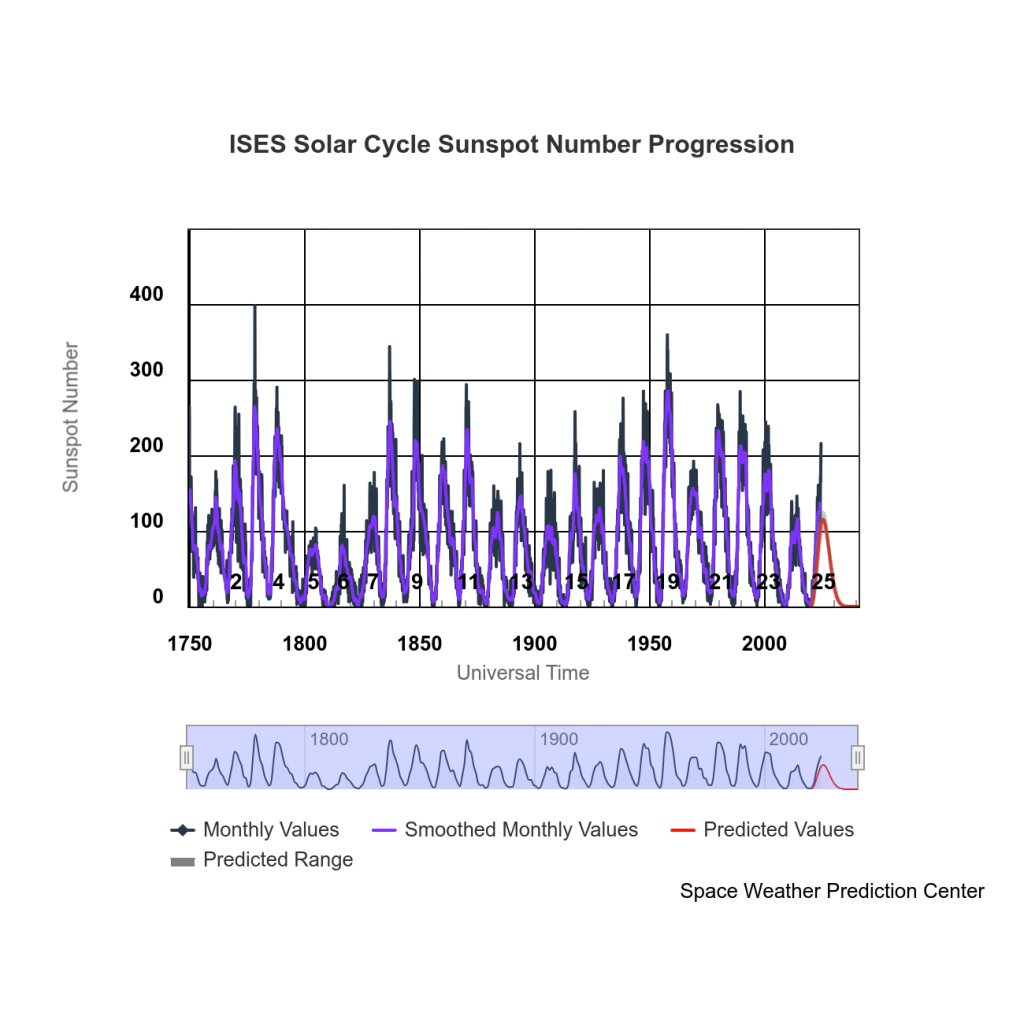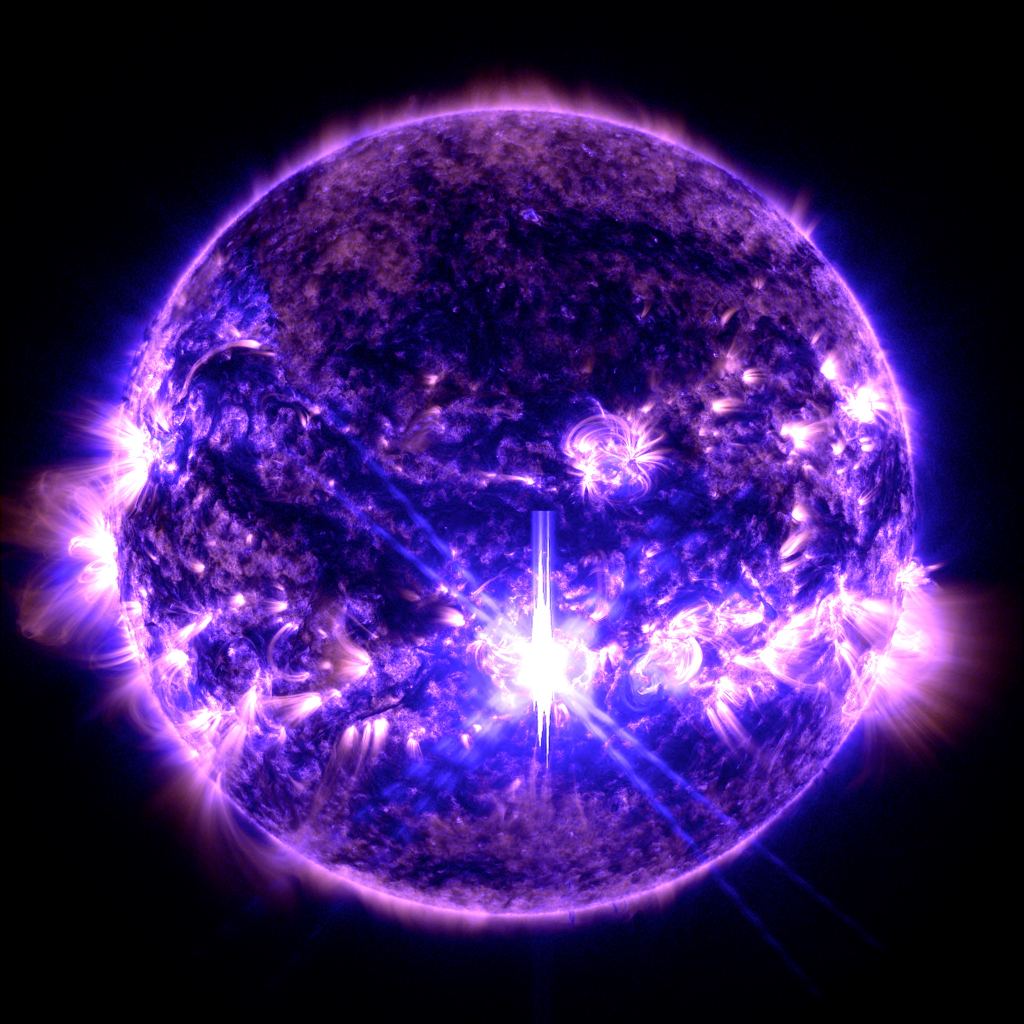For most of human history, the Sun appeared stable. It was a stoic stellar presence, going about its business fusing hydrogen into helium beyond our awareness and helping Earth remain habitable. But in our modern technological age, that facade fell away.
We now know that the Sun is governed by its powerful magnetic fields, and as these fields cycle through their changes, the Sun becomes more active. Right now, according to NASA, the Sun is at its solar maximum, a time of increased activity.
Solar Maximum means pretty much what it sounds like. In this phase of the cycle, our star is exhibiting maximum activity. The Sun's intense magnetic fields produce more sunspots and solar flares than at any other time in its 11-year cycle.
The Solar Maximum is all based on the Sun's magnetic fields. These fields are measured in Gauss units, which describe magnetic flux density. The Sun's poles measure about 1 to 2 gauss, but sunspots are much higher at about 3,000 gauss. (Earth is only 0.25 to 0.65 gauss at its surface.) Since the magnetic field is so much stronger where sunspots appear, they inhibit convective heating from deeper inside the Sun. As a result, sunspots appear as dark patches.
Sunspots are visual indicators of the Sun's 11-year cycle. The National Oceanic and Atmospheric Administration and an international group called the Solar Cycle Prediction Panel watch sunspots to understand where the Sun is at in its cycle.
"During solar maximum, the number of sunspots, and therefore, the amount of solar activity, increases," said Jamie Favors, director of the Space Weather Program at NASA Headquarters in Washington. "This increase in activity provides an exciting opportunity to learn about our closest star — but also causes real effects at Earth and throughout our solar system."
The effects came into focus for many of us recently. In May 2024, the Sun launched multiple CMEs. As the magnetic fields and charged particles reached Earth, they triggered the strongest geomagnetic storm in 200 decades. These created colourful aurorae that were visible much further from the poles than usual. NASA says that these aurorae were likely among the strongest displays in the last 500 years.
Scientists know the Sun is at its solar maximum. But it lasts for an entire year. They won't know when its activity peaks until after they've watched it for months and its activity has declined.
"This announcement doesn't mean that this is the peak of solar activity we'll see this solar cycle," said Elsayed Talaat, director of space weather operations at NOAA. "While the Sun has reached the solar maximum period, the month that solar activity peaks on the Sun will not be identified for months or years."
Each cycle is different, making it difficult to label peak solar activity. Different peaks have different durations and have higher or lower peaks than others.
Understanding the Sun's cycle is important because it creates space weather. During solar maximum, the increased sunspots and flares also mean more coronal mass ejections (CMEs.) CMEs can strike Earth, and when they do, they can trigger aurorae and cause geomagnetic storms. CMEs, which are blobs of hot plasma, can also affect satellites, communications, and even electrical grids.
NASA's Solar Dynamics Observatory captured these images of solar flares below, as seen in the bright flashes in the left image (May 8, 2024 flare) and the right image (May 7, 2024 flare). The image shows 131 angstrom light, a subset of extreme ultraviolet light that highlights the extremely hot material in flares and which is colourized in orange.
via GIPHY
During the solar maximum, the Sun produces an average of three CMEs every day, while it drops to one CME every five days during the solar minimum. The CMEs' effect on satellites causes the most concern. In 2003, satellites experienced 70 different types of failures. The failures ranged from erroneous signals in a satellite's electronics to the destruction of electrical components. The solar storm that occurred in 2003 was deemed responsible for 46 of those 70 failures.
CMEs are also a hazard for astronauts orbiting Earth. The increased radiation poses a health risk, and during storms, astronauts seek safety in the most shielded part of the ISS, Russia's Zvezda Service Module.
Galileo and other astronomers noticed sunspots hundreds of years ago but didn't know exactly what they were. In a 1612 pamphlet titled "Letters on Sunspots," Galileo wrote 'The sun, turning on its axis, carries them around without necessarily showing us the same spots, or in the same order, or having the same shape.' This contrasted with others' views on the spots, some of which suggested they were natural satellites of the Sun.
We've known about the Sun's magnetic fields for 200 hundred years, though at first, scientists didn't know the magnetism was coming from the Sun. In 1724, an English geophysicist noticed that his compass was behaving strangely and was deflected from magnetic north throughout the day. In 1882, other scientists correlated these magnetic effects with increased sunspots.
In recent decades, we've learned much more about our stellar companion thanks to spacecraft dedicated to studying it. NASA and the ESA launched the Solar and Heliospheric Observatory (SOHO) in 1995, and NASA launched the Solar Dynamics Observatory (SDO) in 2010. In 2011, we got our first 360-degree view of the Sun thanks to NASA's two Solar TErrestrial RElations Observatory (STEREO) spacecraft. In 2019, NASA launched the Parker Solar Probe, which also happens to be humanity's fastest spacecraft.
Our understanding of the Sun and its cycles is far more complete now. The current cycle, Cycle 25, is the 25th one since 1755.
"Solar Cycle 25 sunspot activity has slightly exceeded expectations," said Lisa Upton, co-chair of the Solar Cycle Prediction Panel and lead scientist at Southwest Research Institute in San Antonio, Texas. "However, despite seeing a few large storms, they aren't larger than what we might expect during the maximum phase of the cycle."
The most powerful flare so far in Cycle 25 was on October 3rd, when the Sun emitted an X9 class flare. But scientists anticipate more flares and activity to come. There can be significantly powerful storms even in the cycle's declining phase, though they're not as common.
The Sun's 11-year cycle is just one of its cycles, nested in larger cycles. The Gleissberg cycle lasts between 80 to 90 years and modulates the 11-year cycle. The de Vries cycle or Suess cycle lasts between 200 and 210 years, and the Hallstatt cycle lasts about 2,300 years. Both of these cycles contribute to long-term solar variation.
However, even with all we know about the Sun, there are big gaps in our knowledge. The Sun's magnetic poles switch during the 11-year cycle, and scientists aren't sure why.
There's a lot more to learn about the Sun, but we won't run out of time to study it any time soon. It's in the middle of its 10-billion-year lifetime and will be a main-sequence star for another five billion years.
 Universe Today
Universe Today


